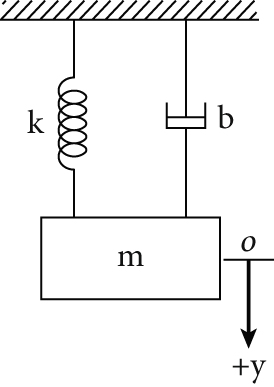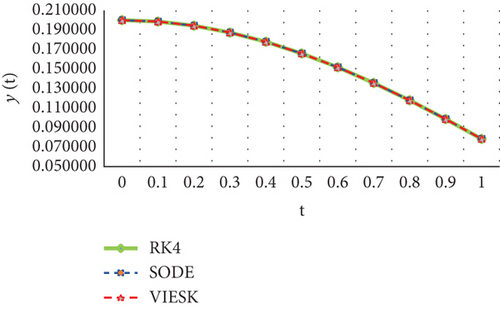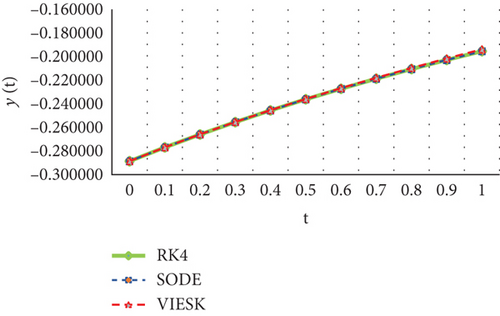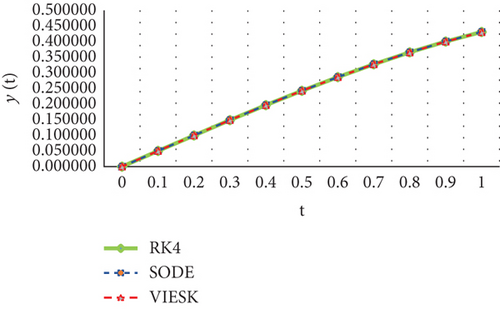Numerical Solutions of Duffing Van der Pol Equations on the Basis of Hybrid Functions
Abstract
In the present work, a new approximated method for solving the nonlinear Duffing-Van der Pol (D-VdP) oscillator equation is suggested. The approximate solution of this equation is introduced with two separate techniques. First, we convert nonlinear D-VdP equation to a nonlinear Volterra integral equation of the second kind (VIESK) using integration, and then, we approximate it with the hybrid Legendre polynomials and block-pulse function (HLBPFs). The next technique is to convert this equation into a system of ordinary differential equation of the first order (SODE) and solve it according to the proposed approximate method. The main goal of the presented technique is to transform these problems into a nonlinear system of algebraic equations using the operational matrix obtained from the integration, which can be solved by a proper numerical method; thus, the solution procedures are either reduced or simplified accordingly. The benefit of the hybrid functions is that they can be adjusted for different values of n and m, in addition to being capable of yield greater correct numerical answers than the piecewise constant orthogonal function, for the results of integral equations. Resolved governance equation using the Runge-Kutta fourth order algorithm with the stepping time 0.01 s via numerical solution. The approximate results obtained from the proposed method show that this method is effective. The evaluation has been proven that the proposed technique is in good agreement with the numerical results of other methods.
1. Introduction
The present article is divided into the following sections: in Section 2, the D-VdP oscillator equation will be described. In Section 3, HLBPFs and operational matrix are reviewed. Our proposed method for solving D-VdP is studied in Section 4. In Section 5, the HPM is described for solving this equation. In Section 6, an error analysis for the suggested methods is presented. Then, Section 7 presents numerical results. Finally, conclusion is described in Section 8.
2. The Duffing-Van der Pol Oscillator Equation

3. Some Properties of Hybrid Functions
In this section, some properties of hybrid functions are recalled.
3.1. Hybrid Legendre Polynomials and Block-Pulse Function
The BPFs on [0, 1) interval are disjoint; that is, for i, j = 1, ⋯, n, we have bi(t)bj(t) = δijbi(t). Furthermore, one of the properties of these functions on interval [0, 1) is orthogonality. The set of hybrid functions bij(t) is taken as a complete orthogonal system in L2[0, 1), since bij(t) are a combination of BPFs and Legendre polynomials; each of them is orthogonal and complete.
3.2. Approximating a Function
3.3. The Operational Matrix of Integration
3.4. The Product Operational Matrix of the HLBPFs
4. The HLBPFs for Solving Duffing-Van der Pol
4.1. Converting Duffing-Van der Pol Equation to a Volterra Integral Equation of the Second Kind
4.1.1. Evaluating Yγ
So, the component of Yγ can be calculated in terms of the component of the unknown vector Y.
4.2. Converting Duffing-Van der Pol Equation to a System of Ordinary Differential Equation of the First Order
5. Homotopy Perturbation Method
5.1. The HPM for Solving Duffing-Van der Pol
6. Error Analysis
In this section, we calculate the error bound of the presented method for the approximate solution D-VdP equation in Section 4. When we convert the D-VdP equation to a SODE, we refer the readers to the error bound that is calculated in [22], and we get an error bound for the approximate solutions of nonlinear VIESK which implies the convergence of the present method in Section 4, and we have the following theorems. Suppose that Ω = ⋃1≤i≤nΩi where Ωi = [(i − 1)/n, i/n).
Theorem 1. Suppose that y ∈ Cm[0, 1] is an m times continuous function and |y(m)(t)| ≤ λ, such that , where yi is the restriction of to Ωi and Ei = span{bi0(t), bi1(t), ⋯, bi(m − 1)(t)}, i = 1, 2, ⋯, n. If is the best approximation of yi(t) from Ei, where , then approximates y(t) with the following error bound
Proof. Let . Assume that P(m − 1)i for i = 1, 2, ⋯, n, are the interpolating polynomials to yi at points tj, j = 0, 1, ⋯, m − 1 that implies the zeros of m-degree-shifted Chebyshev polynomials in the interval [(i − 1)/n, i/n). Then, we have [35]
The following equation is obtained by considering the estimates for Chebyshev interpolation nodes [36]. Therefore, we obtain
Since is the best approximation of yi from Ei and P(m − 1)i ∈ Ei, we obtain
Now,
The following equation is obtained by calculating the square root of both sides and through replacing CTB by ,
Theorem 2. Assume that is the hybrid expansion of function k with the real value expressed by Equation (15) and k is adequately smooth on every single subdomain [(i − 1)/n, i/n) × [(j − 1)/n, j/n), i, j = 1, 2, ⋯, n, and then, there is a positive constant γ as shown in the following
Proof. Suppose that , where kij is the restriction of k to [(i − 1)/n, i/n) × [(j − 1)/n, j/n). For i, j = 1, 2, ⋯, n assume that P(m − 1)ij is the interpolating polynomial to kij at points (sr, tl), where sr, tl, r, l = 0, 1, 2, ⋯, m − 1 implies the zeros of m-degree-shifted Chebyshev polynomials in [(i − 1)/n, i/n), [(j − 1)/n, j/n) intervals, respectively, and then, we have [35]
Now, suppose that γ = max{γ1, γ2, γ3}, in which
Then, the equation mentioned in the following is obtained by considering the estimates for Chebyshev interpolation nodes [36].
Since is the best unique approximation of kij from Ei × Ej, we obtain
Now,
The following equation is obtained by calculating the square roots and replacing BTKB, by . Then, we have
Lemma 3 (Gronwall Inequality). Let e(t), a(t), and b(t) be real continuous functions defined on Ω, for fixed t0 ∈ Ω. If
Lemma 4. Assume that {kj}, j ≥ 0 is a given nonnegative sequence, and the sequence {εn} satisfies ε0 ≤ ρ0 and
Now, consider the nonlinear integral equation (Equation (27)) or under the following assumptions:
Theorem 5. Suppose y and are, respectively, the exact and approximate solutions of Equation (27) obtained by Section 4. Suppose also that the assumption (1-4) is fulfilled. Then, there exist positive constants ζ and ϱ such that
Proof. From Equation (28), we have
The above equation can be rewritten in the following form:
By using the mean value theorem, the following result is concluded
Since 0 ≤ t < 1, by taking L2-norm in Equation (66) and applying the error bounds obtained in Theorems 1 and 2, we get
From Equation (84), we have that for any t ∈ Ωi = [(i − 1)/n, i/n),
Let t ∈ Ω1 = [0, 1/n), and then, the inequality (Equation (87)) reduces to
It follows from Gronwall Inequality in Lemma 3 that
Therefore, we get
By using the Gronwall inequality for t ∈ Ω, we obtain
Therefore, . Now, taking L2-norm in Equation (92), we obtain
Now, a suitable application of Lemma 4 to Equation (95) yields
Since, , regarding the disjointness of ei for i = 1, 2, ⋯, n, we obtain
By taking the square root of both sides, we get
Finally, considering the error bound of ‖I‖2 obtained in Equation (82) and substituting ϑ with ϑ = 1 + (ϱ/n)exp(ϱ/n), we get
It is obvious that error bound tends to zero as n and m tend to infinity.
7. Numerical Examples
In this section, the HLBPFs are applied with n = 2, m = 8, and Tf = 1.00001 for all examples. As a result, the methodology suggested in Section 4 is used to find the approximate solution directly. In these examples, the approximate results given by presented method, HPM, and ADM are compared to the numerical solution obtained from RK4. In all cases, the results are presented in Tables 1–3. Based on these results, we see that the results of the HLBPFs are closer to the numerical solutions obtained using RK4. All experiments are implemented using MATLAB.
Example 7.1. Take the following unforced Van der Pol equation into consideration [39, 40].
The approximate analytical solution of Equation (100) is obtained by method’s RK4, HPM, and ADM.
| t | Approximate solution (RK4) | Absolute error | |||
|---|---|---|---|---|---|
| |RK4-ADM| | |RK4-HPM| | |RK4-VIESK| | |RK4-SODE| | ||
| 0 | 0.200000 | 0 | 0 | 2.88 × 10−10 | 1.13×10-11 |
| 0.1 | 0.198569 | 1.36 × 10−12 | 3.98 × 10−9 | 1.42 × 10−8 | 3.92 × 10-12 |
| 0.2 | 0.194322 | 1.90 × 10−12 | 7.68 × 10−8 | 3.61 × 10−8 | 2.99 × 10-12 |
| 0.3 | 0.187362 | 1.33 × 10−10 | 4.63 × 10−7 | 3.18 × 10−7 | 6.64 × 10-12 |
| 0.4 | 0.177826 | 1.53 × 10−9 | 1.67 × 10−6 | 1.22 × 106 | 1.24 × 10-11 |
| 0.5 | 0.165889 | 1.06 × 10−8 | 4.51 × 10−6 | 3.41 × 10−6 | 1.93 × 10-11 |
| 0.6 | 0.151756 | 5.34 × 10−8 | 1.00 × 10−5 | 7.76 × 10−6 | 1.99 × 10-11 |
| 0.7 | 0.135662 | 2.15 × 10−7 | 1.94 × 10−5 | 1.53 × 10−5 | 2.42 × 10-11 |
| 0.8 | 0.117866 | 7.33 × 10−7 | 3.37 × 10−5 | 2.68 × 10−5 | 2.90 × 10(-11) |
| 0.9 | 0.098649 | 2.19 × 10−6 | 5.35 × 10−5 | 4.32 × 105 | 3.44 × 10−11 |
| 1.0 | 0.078307 | 5.90 × 10−6 | 7.86 × 10−5 | 6.45 × 10−5 | 3.84 × 10−11 |
| t | Approximate solution (RK4) | Absolute error | |||
|---|---|---|---|---|---|
| |RK4-ADM| | |RK4-HPM| | |RK4-VIESK| | |RK4-SODE| | ||
| 0 | -0.288680 | 0 | 0 | 2.63 × 10−10 | 1.13 × 10−11 |
| 0.1 | -0.277018 | 1.13 × 10−7 | 3.05 × 10−5 | 3.99 × 10−6 | 3.04 × 10−12 |
| 0.2 | -0.265993 | 8.40 × 10−6 | 4.87 × 10−5 | 2.76 × 10−5 | 8.79 × 10−13 |
| 0.3 | -0.255551 | 1.11 × 10−4 | 1.11 × 10−4 | 8.37 × 10−5 | 1.21 × 10−12 |
| 0.4 | -0.245646 | 7.23 × 10−4 | 6.97 × 10−4 | 1.80 × 10−4 | 4.04 × 10−12 |
| 0.5 | -0.236235 | 3.20 × 10−3 | 2.06 × 10−3 | 3.19 × 10−4 | 6.73 × 10−12 |
| 0.6 | -0.227283 | 1.11 × 10−2 | 4.67 × 10−3 | 5.03 × 10−4 | 2.81 × 10−12 |
| 0.7 | -0.218756 | 3.25 × 10−2 | 9.16 × 10−3 | 7.30 × 10−4 | 1.99 × 10−12 |
| 0.8 | -0.210624 | 8.41 × 10−2 | 1.64 × 10−2 | 9.96 × 10−4 | 2.25 × 10−12 |
| 0.9 | -0.202863 | 1.98 × 10−1 | 2.74 × 10−2 | 1.30 × 10−3 | 2.54 × 10−12 |
| 1.0 | -0.195446 | 4.32 × 10−1 | 4.37 × 10−2 | 1.63 × 10−3 | 2.19 × 10−12 |
| t | Approximate solution (RK4) | Absolute error | |||
|---|---|---|---|---|---|
| |RK4-ADM| | |RK4-HPM| | |RK4-VIESK| | |RK4-SODE| | ||
| 0 | 0.000000 | 0 | 0 | 1.18 × 10−10 | 8.80 × 10−12 |
| 0.1 | 0.050042 | 4.18 × 10−12 | 1.54 × 10−9 | 6.04 × 10−7 | 6.04 × 10−12 |
| 0.2 | 0.099832 | 8.39 × 10−12 | 5.37 × 10−8 | 2.66 × 10−6 | 8.03 × 10−12 |
| 0.3 | 0.148870 | 1.25 × 10−11 | 4.36 × 10−7 | 9.80 × 10−6 | 1.22 × 10−11 |
| 0.4 | 0.196656 | 1.64 × 10−11 | 1.94 × 10−6 | 2.76 × 10−5 | 1.80 × 10−11 |
| 0.5 | 0.242704 | 1.99 × 10−11 | 6.15 × 10−6 | 6.38 × 10−5 | 2.35 × 10−11 |
| 0.6 | 0.286537 | 2.26 × 10−11 | 1.57 × 10−5 | 1.26 × 10−4 | 2.07 × 10−11 |
| 0.7 | 0.327703 | 1.90 × 10−11 | 3.42 × 10−5 | 2.22 × 10−4 | 2.64 × 10−11 |
| 0.8 | 0.365772 | 3.88 × 10−11 | 6.63 × 10−5 | 3.58 × 10−4 | 2.64 × 10−11 |
| 0.9 | 0.400343 | 4.51 × 10−10 | 1.17 × 10−4 | 5.39 × 10−4 | 2.72 × 10−11 |
| 1.0 | 0.431051 | 2.67 × 10−9 | 1.90 × 10−4 | 7.68 × 10−4 | 2.80 × 10-11 |
Table 1 can be used to compare the results of the absolute errors of methods with RK4. Figure 2 shows the approximate answers obtained by HLBPFs for Equations (101) and (102) with RK4.
Example 7.2. In this example, the famous Duffing-Van der Pol equation is included like the following [41, 42].

Table 2 can be used to compare the results of the absolute errors of methods with RK4. Figure 3 shows the approximate answers obtained by HLBPFs for Equations (106) and (107) with RK4.
Example 7.3. Let us solve the following oscillator equation [11, 43–45].
The approximate analytical solution of Equation (110) is obtained by method’s RK4, HPM, and ADM.

Table 3 can be used to compare the results of the absolute errors of methods with RK4. Figure 4 shows the approximate answers obtained by HLBPFs for Equations (111) and (112) with RK4.

8. Conclusions
In this work, we solved the D-VdP problem by transformation into a Volterra integral equation of the second kind and a system of ordinary differential equation of the first order. It was found that the numerical solution of these equations is using the expansion based on HLBPFs and their integration operational matrix. In this technique, integration is not needed because examples are solved quickly, and calculation time is minimized by employing the matrices P and . The advantage of our proposed method is its high accuracy when the D-VdP equation converted to a SODE.
Conflicts of Interest
The authors declare that they have no conflicts of interest.
Authors’ Contributions
All authors contributed to the study’s conception.
Open Research
Data Availability
No data were used to support this study.




